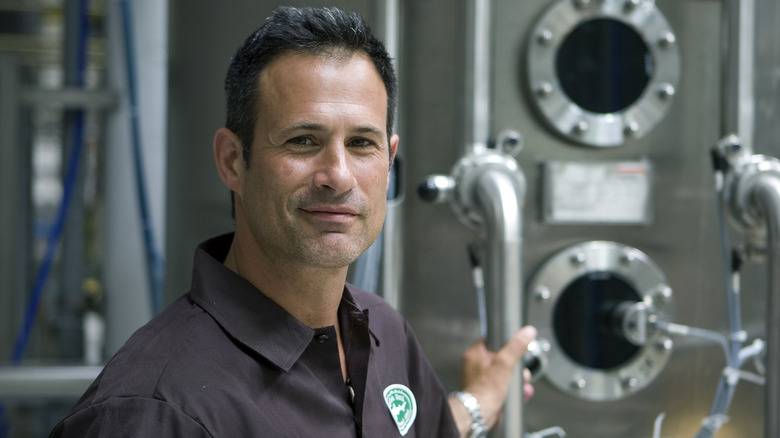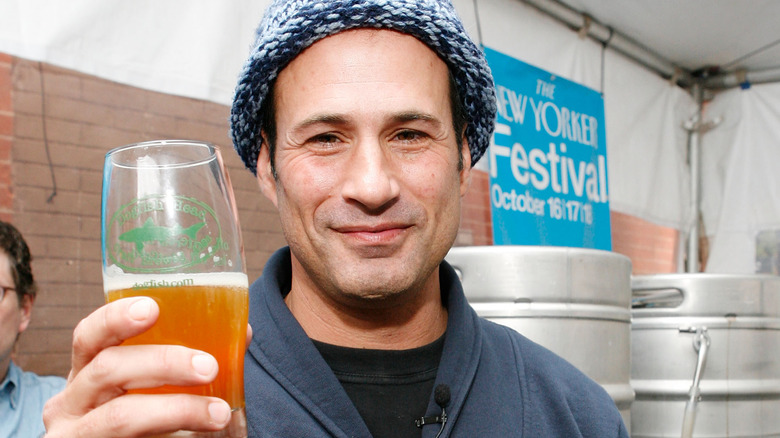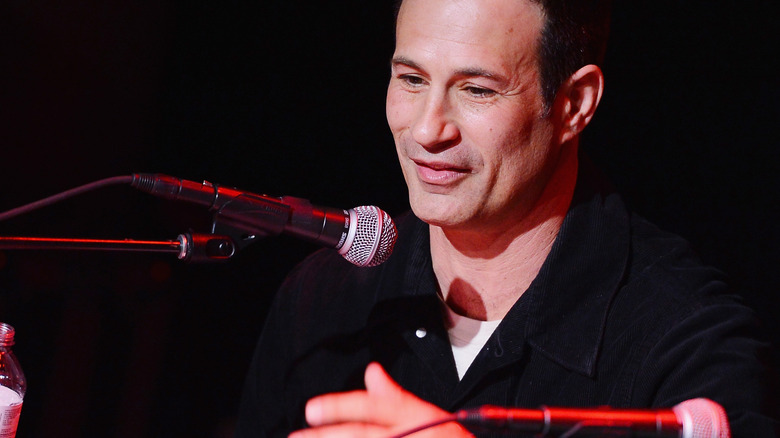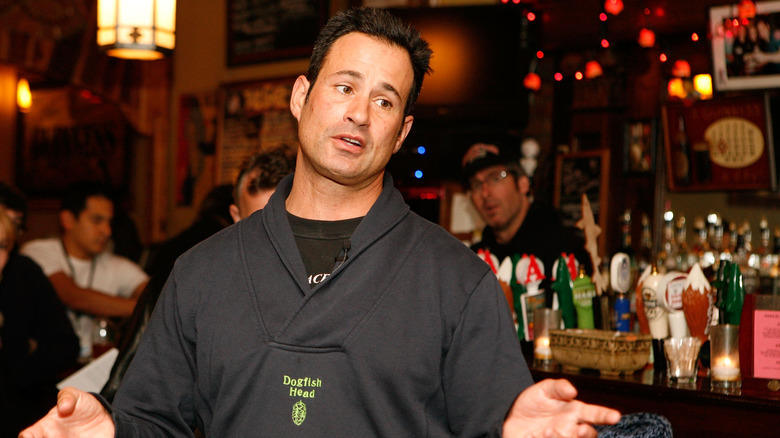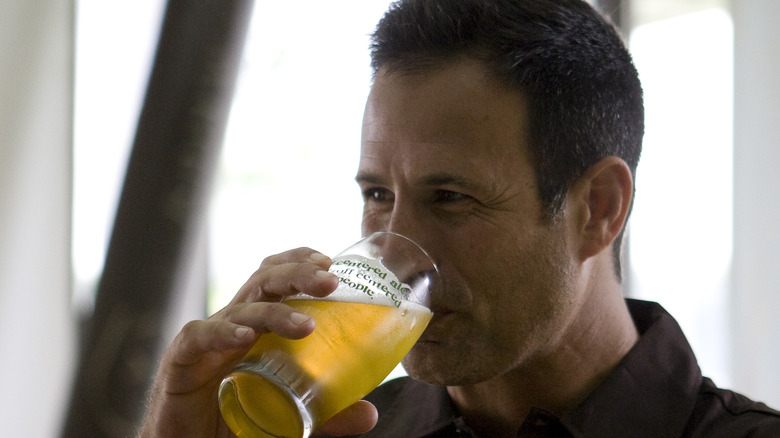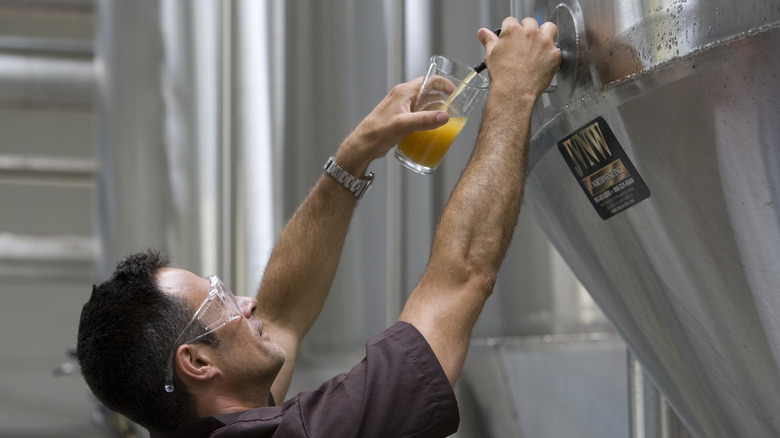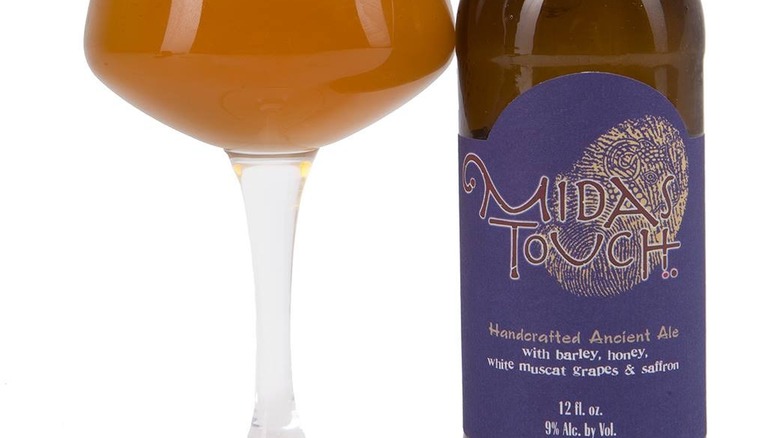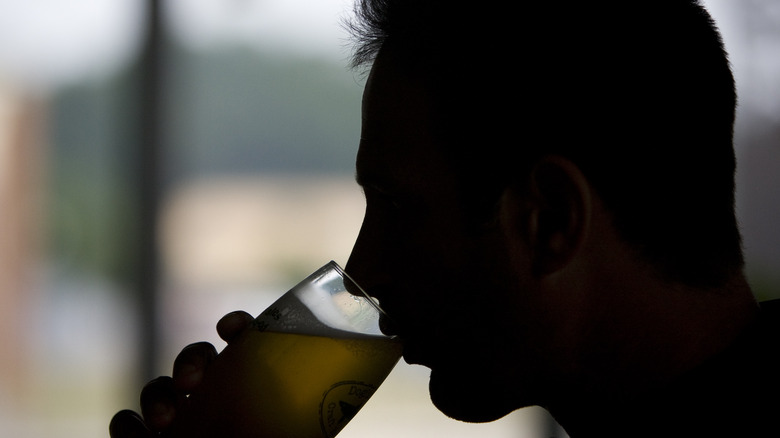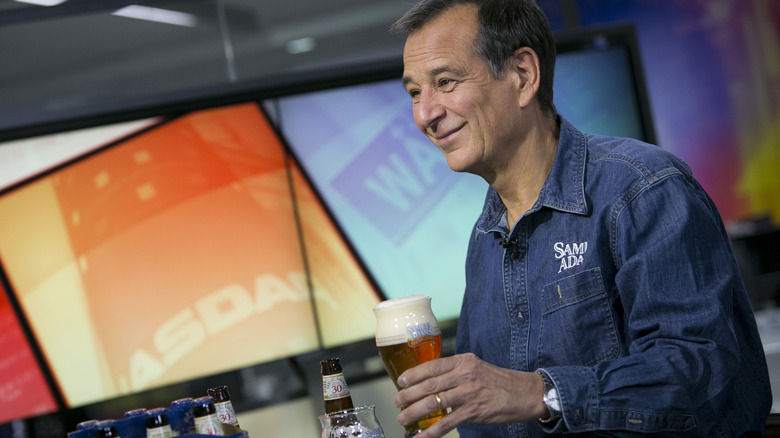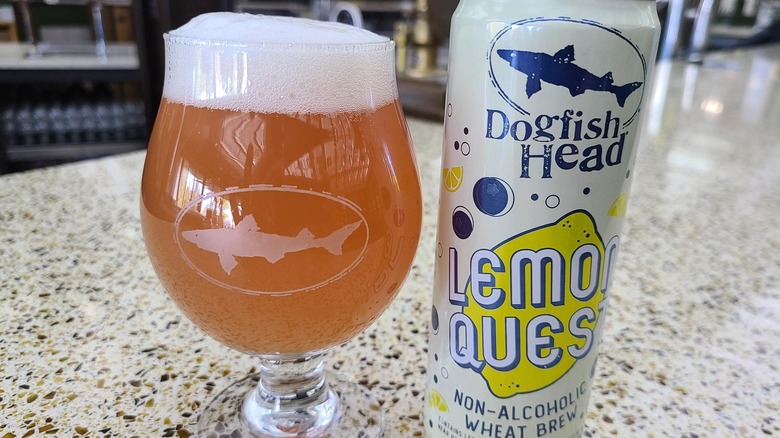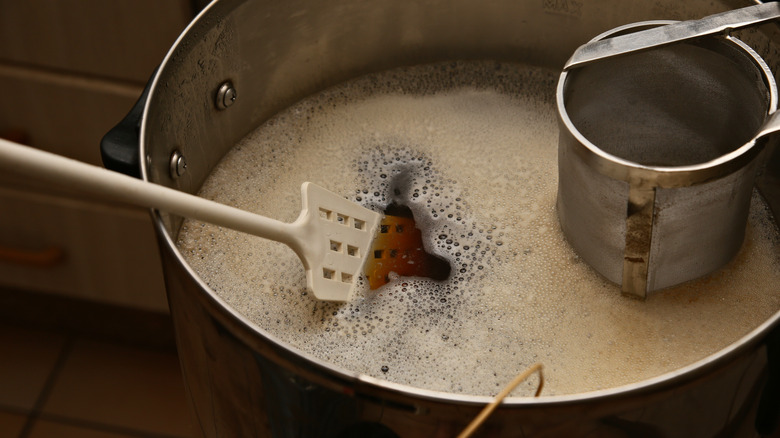Dogfish Head Founder Sam Calagione Talks All Things Craft Beer - Exclusive Interview
Dogfish Head Brewery founder Sam Calagione didn't grow up planning to become of the most influential brewers in America and, as a major player in America's craft beer revolution, a beer brewer with global impact. In fact, up until shortly after graduating from college, Calagione had hardly paid a bit of attention to the beer he drank. In a recent interview with Mashed, Calagione shared how his journey into the world of craft beer came after a sudden awakening to what the classic beverage could be.
Had the man behind such acclaimed beers as the Dogfish Head 60-Minute IPA, SeaQuench Ale, or the mighty Utopias Barrel-Aged World Wide Stout (which has an ABV clocking in at 17.3%) not ended up working in a New York City bar shortly after school, the world may never have known beer like these and more. Today, Dogfish Head Brewery has partnered with The Boston Beer Company of Sam Adams fame, and working in partnership with Boston Beer's Jim Koch has only helped Dogfish Head grow larger still. The brewery now also involves a distillery, three restaurants, an inn, a partnership with The Nature Conservancy, has been featured in TV shows like "Beer Wars" and "Brew Masters," and of course beers with a presence in bars, restaurants, and retail locations in all 50 states.
But why is the brand called Dogfish Head, anyway? Pretty simple: the name comes from Dogfish Head, a peninsula of Southport, Maine where Calagione spent time as a kid.
What got Sam Calagione into brewing in the first place?
What got you into brewing in the first place?
Like everyone I drank the sh—–st, cheapest beer in college, and then right after college I worked in a bar called Nacho Mama's Burritos, on the Upper West Side, 111 and Broadway. When I worked at that bar that's when I got to try Chimay Red and Sierra Nevada Celebration. My mind was blown and within weeks I started home brewing.
When did you know beer was a lifelong calling?
Within months I started writing a business plan for Dogfish. And really the front page of this thing was: We will be the first commercial brewery in America committed to making the majority of our beers outside the Reinheitsgebot, incorporating culinary ingredients into our recipes. And that was true when we were the smallest brewery in the country and still true today as a top 20 American craft brand. So, early chicory stout with coffee and chicory, Aprihop, which was one of the first fruited IPAs — we've been brewing with these culinary ingredients for a long time. And then maybe 10 years ago the national dialogue started to morph from the local bought movement into the better for you movement, and Dogfish was already innovating with fruits and herbs and spices. Namaste was really our first better for you, active lifestyle brand, a yogurt style white beer, and then Slightly Mighty, Sea Quench Ale, and now Lemon Quest.
What people get wrong about American craft beer, according to Sam Calagione
What do you wish people understood more about American beer?
It was only 30 years ago that American beer was considered the laughing stock of the global beer community because it was just seen as this monolithic, homogenized light lager and that was it. But the craft brewers not only brought it back in America, but really just inspired cultures around the world to rethink what commercial beer could be. And to consider looking at indigenous ingredients in their own regions and countries, whether it is Italy, Scandinavia, Australia, Brazil — to create their own styles and their own new creative concepts for beer styles.
And Dogfish is really proud to be part of that legacy ... There's recognition for [Americans] bringing so much diversity and creativity, passion, and fun back into the industry, to the global, commercial brewing community. There's never been a better time to be a beer maker or a beer drinker in America than there is right now.
Sam Calagione's advice for the craft brew curious
What advice do you have for someone who wants to start getting into drinking craft beers?
Well, I would say there are styles that are more graceful, baby steps out, the first baby steps out onto what I would call the flavor bridge. As ubiquitous as American craft brewers may seem today, because today there are over 8,000 brewers in America, and the average American now lives within nine miles of a local brewery ... but collectively, all American craft brewers together represent less than 14% of market share in America. So, we are still up against these global juggernauts that mostly focus on light lager beer. So, if you're going to take a step away from light lager, terra firma, I think the most approachable craft beer style to take that first step with are lower ABV IPAs, like our Slightly Mighty, like your 60 Minute at 6%, or other craft beers session IPAs. Or wheat beers. Be it the German Hefeweizen style, the Belgian style white beers that have some nice fruitiness to them, with the addition of orange and coriander.
Or refreshing sours especially as we head into the warmer months, and the best selling sour beer of last year is Dogfish SeaQuench Ale. I think a big reason it was so successful is that it's not super hoppy, and it's not super strong. I think that's the misconception about craft beer in general, for non-craft beer aficionados, is that it is all bitter and strong. Well, SeaQuench Ale has less hops than Miller Lite and it has sea salt and limes, so it goes to a margarita drinker, plus there is a nice bright acidity to it that would appeal to a Pinot Gris drinker as well. So, there are styles really lend themselves to bringing new drinkers into the fold to try craft beer.
Mistakes people make when trying new craft beers, according to Sam Calagione
What is the biggest mistake you see when people are drinking beers?
I think the biggest mistake beer drinkers make is [because] the world's biggest breweries for the last 50 years have been telling people, they are advertising ice cold beer is the best way to drink your beer. But when you have something that is ice cold, it is essentially freezing your taste buds and numbing them and you are not getting the full sensory experience. So, in general, I think Americans drink their beer too cold. Now, there are some styles that I would recognize as outliers that are truly best on the colder side. I think of things like Pilsner as one of those styles, a really nice cold, crisp Pilsner. Or lower ABV session or low-cal IPAs are really nice colder. Whereas bigger beers like 90 minute IPA, or stouts and porters I tend to think are better closer to cellar temp, than they are ice cold.
What are a couple of styles of beer that you wish people knew more about?
Well, I would certainly put at the top of that list is the Pilsner style and it is interesting that of the 8,000 craft beers in the country, I would say 7,700 of them focus on the ales instead of lagers. Sam Adams is the largest, and Yuengling, of the American lager breweries, but Pilsner is a lager style that is light, it's refreshing, and it is hoppy, kind of like an IPA, but it is from the lager side of the beer family. So, I think Pilsners are ripe for a renaissance. And then I do think sour beers, fruity sour beers. Again, because I feel that they can appeal to cocktail lovers [and] wine lovers as much as they appeal to beer lovers.
How Sam Calagione developed Dogfish Head's famed continuously hopped IPAs
How long did it take you to work out the recipe for the 60-minute, 90-minute, and 120-minute IPAs?
Well, in the case of those beers, so that was in the late '90s, back when IPAs were not the hot style of craft beer renaissance. For today's craft beer drinker, there is no other single beer style in the craft beer renaissance that has moved the needle volumetrically as much as IPAs. It is essentially responsible for moving the craft beer movement in America out of the niche community and into the mainstream. But in the case of 60, 90, and 120, it was really just a fateful day where I was watching a cooking show on TV and learned about chefs adding tiny pinches of spice continually while they simmer dishes, and that gave me the confidence to MacGyver an old vibrating football game and convert it with a bucket, Duct tape, and 2 by 4s into our first continually hopping device, which I angled over my boil kettle and the hops would vibrate down the football game into the beer for 90 minutes. And we made it 9% alcohol and 90 IBUs.
So, an easy concept for the consumer to understand and that unique proprietary continual hopping approach that we use, makes our IPAs extremely beautifully hoppy, without being crushingly bitter. And we are really proud that the original continual hopping device is now in the permanent collection of the Smithsonian, along with the Wright brothers' plane and the Apollo [capsules]. That's an example of one epiphany that helped me build an entire recipe concept. Not just for one beer ... but a family of continually hopped beers. Starting with 90 chronologically at 9%, then we brewed 60 minute at 6% and then a few years later we brewed the world's strongest IPA, 120 minute, all built around that unique continual hopping proposition.
The wildest beers the Dogfish Head team has ever made
What is the wildest beer you have ever brewed?
Oh, there is one at Dogfish that we have fun with every few years. We have done a lot of ancient ales and reviving lost recipes from ancient civilizations, whether it is our Midas Touch, which is a beer, mead, and wine hybrid based on molecular residue found in a 2,700-year-old tomb in Turkey believed to be King Midas's tomb. So, that was a fun beer. But then I learned, maybe 10 years ago, about this Central and Southern American tradition of brewing these corn beers, where through process of elimination millennia ago, the brewers learned that human saliva contained natural enzymes that can break down the starch of corn into sugar. So, they would chew on the corn kernels and make beer with it the next day, called Chicha. And so, there are all these different regional recipes for Chicha, but the constant is corn.
And so at Dogfish every few years we invite our co-workers and we offer each co-worker two buckets. One bucket is filled with Peruvian blue corn and the other bucket is empty. And we ask them would they rather stay at work, or chew on the corn. We put the chewed corn in the empty buckets and then the next day we brew a batch of Chicha with it that we sell at our brewpub only. We don't distribute it. It is a pain in the a**, it's a labor of love, but the fact that we can make a beer with all of our own saliva and then boil it and add local strawberries to it and it turns out beautiful, really makes people rethink what a beer can be.
The worst beers Dogfish Head ever created
Have there been any beers you guys have brewed that have turned out to be just absolutely disastrous?
Oh yeah, quite a few. Some of them you define as a disaster just because they might be delicious but they are an absolute pain in the a** to brew, so they are not sustainable. Like we won a Great American Beer Festival award, which is the highest award in our country, for a beer called Choc Lobster, and it was a porter made with cocoa nibs and hundreds of pounds of Maine lobsters. Because there's a tradition, ancient tradition from the British empire of adding oyster to stouts, because there are great minerals in the shells of oysters that the yeast likes to eat. And so we said, "All right, we will do that one better." I grew up in Maine, I had my buddy from high school up there [who] is a lobsterman, he's going to send down the lobster. So, we made this amazing stout beer with cocoa nibs and lobster, and it was delicious, but our brewery stunk like a fish house for a week after that brew day. So, the brewers never wanted to make that beer again.
But then there are some that we just — you are always throwing colorful ideas at the wall, as a creative brewer, like Jackson Pollock with ingredients instead of paints. And one that I thought was going to be so fun, because Gose, is a German beer style that incorporates salt into it, and knowing that there is such a thing as Oyster stout, we said, "All right, we played around with lobsters, other people have played around with oysters. What's another shellfish we can play around with?"And we did a beer using snails and it had an awesome name, it was Escargose, so it was a Gose made with escargot. And I was like, "Oh my God, the name is perfect. This beer is awesome. We definitely have to bring it to market." But we used the snail meat and the snail shell in the recipe, and it just ended up tasting like slugs and low tide. So Escargose never saw the light of day.
Sam Calagione on partnering with Sam Adams
How has joining forces with the Boston Beer company worked out so far?
It has been an amazing ride. This was the first commercial brewery to collaborate with the Sam Adams brand about a decade ago. Jim and I, and a bunch of Boston Beer co-workers, [made a] beautiful beer they got together and called Savor It. Where we used our Dogfish distillery to distill rose water and then we made a beer using the rose water to replace the normal brewing water, and then Jim sourced a bunch of really cool edible flowers, until it was this beautiful floral beer we brewed together, and spending time our two teams together 10 years ago, made me see just how similar the co-workers at Boston Beer were to the Dogfish co-workers. We both viewed the opportunity to create beer as an art form.
And it has also just been super helpful because our portfolios of what we make are so complimentary, right? Because Boston Beer has the number one cider in America, with Angry Orchard, the number one lager beer, craft lager with Sam Adams. The number one tea with Twisted Tea, the number two in world market share seltzer with Truly. Whereas Dogfish focuses on IPAs. The number one low-cal IPA in America, the Slightly Mighty. Sours, the number one sour in America with SeaQuench. So, that was the other awesome thing about coming together with one national sales force, we can now bring the most dynamic and exciting, high-end beverage portfolio to market collectively, beyond just beer.
Sam Calagione on the rise in popularity of non-alcoholic beer
Do you think the surge in popularity of non-alcoholic beer is here to stay?
I believe that it is here to stay ... There's this consultant Bump Williams, who does this really cool study every year where he asks top distributors, suppliers, brewers, and retailers, what is their most critical strategy for the next five years, to grow? And for brewers it is innovation. For distributors, it is not focusing on too many brands. But for retailers, and this includes grocery stores, the number one growth driver is "better for you." So, that movement is not going away. And Dogfish has been fully immersed in that movement before it was called the "better for you" movement 10 or 12 years ago when we first did Namaste as our yogurt wheat beer, we were part of that movement.
And so, the non-alc movement is really part of this greater movement of better for you ... Other countries have a much bigger market share for non-alc than America does. Like Germany, Scandinavia, and maybe that comes from more draconian laws of their society against drunk driving. But I also think to some degree, there is more of a priority placed upon personal health and diets in those countries, than maybe America until recently.
Where I think today's younger beer drinkers are also the ones that mandated avocado toast gets on more restaurant menus. And they are making wellness choices and diet choices that are very different than our older American generations. And at the center of that choice space is prioritizing better for you ingredients, better for you drinks. And what is interesting for us is Lemon Quest we built our non-alc basically on the same base as our Sea Quench Ale. In fact, we used the same molecular beverage scientist to develop the recipe on a molecular level to be as refreshing as possible. And to incorporate ingredients that are recognized in the greater active lifestyle movement. So, Lemon Quest not only has wheat and lemon in, but it has açai, very polyphenol-rich hops from hops, and sea salt. So, all ingredients recognized as refreshing and part of an active lifestyle. But it just drinks as this beautiful, light, refreshing, unpretentious beverage.
And we are not trying to go after people that never drink beer, there are other good brands that do that. We are trying to go up to people that might want to go for a long bike ride after having a few beers, while having a few beers, and not be thinking about, "Is my motor skills compromised by alcohol?" People that are out drinking with their buddies for a night and they're like, "You know I've got a big meeting, a presentation at 9 a.m. I'm going to use Lemon Quest as a pacer beer. And I'm going to drink two regular IPAs and then between each of those have a couple of Lemon Quests." So, they are part of the moment with their friends, not this weird dislocated vibe, it is still inclusive. It is still very much a brew, in all sensory capacities, but it's one that you are not going to get hungover with.
Sam Calagione on getting people outside and active
What are your hopes for the Mother Nature, Let's Do This program and the partnership with the Nature Conservancy?
Lemon Quest is the only Dogfish package that calls out our proud relationship with the Nature Conservancy right on the package. We are donating $50,000 specifically with Nature Conservancy this year around the Mother Nature, Let's Do This initiative, but Dogfish cumulatively last year went over $1 million donated to the Nature Conservancy. And we are just really big believers in their mission because it overlaps almost perfectly, almost fully with ours. So, the Nature Conservancy's mission is all about protecting the open lands and waters on which all life depends. And those same lands and waters are [part of our] natural culinary systems. We went in and built programs, that's a year-long program, Mother Nature, Let's Do This. But the biggest focus period of it will be the summer, where you will see displays from coast to coast of Dogfish beers and Lemon Quest and canned cocktails under a big banner saying: "Mother Nature, Let's Do This." There will be opportunities for consumers who care about the Nature Conservancy's mission to opt-in and make donations.
But generally, the program is all about getting people outside, hopefully to drink our active lifestyle beers and Lemon Quest in the beauty of mother nature. But also outside just being active, right? Because we all know we are coming through this COVID cabin fever moment together, and fortunately we are seeing some light at the end of the tunnel. And I think a lot of people are going to be outside, traveling, camping, going for bike rides, socializing outside where it is safer to do so this summer. And Dogfish Head really wants to be part of that moment of celebration, personal physical health, but also mental health as we come through this challenging moment together.
How has the pandemic impacted Dogfish Head?
What has it been like for Dogfish Head and for you this pandemic year?
It has been challenging, as it has for so many people globally. In the context of our company, when Mariah, my wife, and I opened Dogfish 26 years ago, it was the smallest commercial brewery in America. [We had] grilled cheese sandwiches and homemade beer. So, our company has been a restaurant company for as long as we have been a brewery company and overnight we had to shut down our restaurants, and overnight we lost 30% of our sales through restaurants coast to coast, since that's how much Dogfish sells in draft. So, we had to really rebuild our business last year and quickly pivoted to more of our products in cans, more of our products in some bigger packages, going from six-packs to 12-packs as people were in the pantry loading moment and wanted to buy in bigger volumes,[and] make less trips out to retailers.
So, I think we reacted with grace and aplomb as much as we did, and I just think beer itself is such a great catalyst for bringing people together for socializing, it's a drink of moderation. In the case of Dogfish the [beers] are designed to go beautifully with the outdoors because they are built to be outdoorsy beers. So we feel really well-positioned as a brand and as a company to come out of this moment with strength and to hopefully really excite people with how intentional we are with our respect for mother nature and for the all-natural ingredients that we put into our beers and canned cocktails.
Sam Calagione's advice for home brewers
What advice do you have for anyone who wants to get into home brewing?
I would say walk before you run, go visit a local home brew store or search online for great, beer-specific websites, MoreBeer.com is a favorite of mine. Because if you buy a brew kit from a non-specific beer site you really have no support system, where if you buy from a home brewing site they will give you an 800 number and walk you through your first batch. There is a big difference in complexity and time to do a batch of home brew if you skip one of the longer, more laborious stages, which is the mashing stage. So, I would recommend if you are just going to brew your first batch, get a kit which has malt extract, which is basically syrup, where another company has done the work of extracting the good sugars from the barley and making it into a syrup, so you don't have to deal with the messiness or time. Basically that initial hour and a half of mashing pure barley, and do a batch that has extract as the main source of fermentable sugars.
Still have fun adding specialty grains, fruit, and spices, whatever your favorite culinary ingredients are, don't treat it as too precious. Don't feel like you have to brew the next 60-Minute IPA or Sierra Pale Ale — try to brew a beer that expresses your own culinary interests by thinking outside the box with a fun ingredient to add to an extract-based first batch of home brew.
Check out the Dogfish Head website for a complete list of their beers and news about upcoming flavors.
